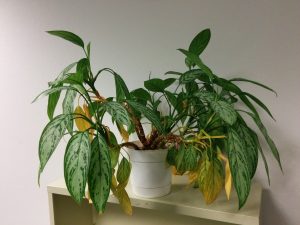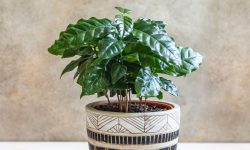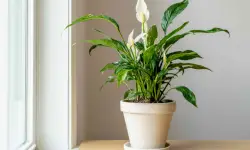Chinese evergreen plants (Aglaonema spp.) are cherished for their attractive foliage. They are among the popular choices for indoor plant enthusiasts. But it can be disheartening to see the once vibrant green leaves of your Chinese evergreen turning brown.
Brown leaves indicate an underlying issue that needs to be addressed promptly to revive the plant’s health and beauty. This article explores the most common causes of Chinese evergreen leaves turning brown and provides comprehensive solutions to tackle each problem.

Causes of Chinese Evergreen Leaves Turning Brown
Overwatering
Overwatering is a common mistake that can lead to brown leaves in Chinese evergreen plants. When the roots are constantly submerged in excess water, they suffocate and begin to rot.
This lack of oxygen and the accumulation of moisture causes the leaves to turn brown. To remedy this issue, ensure that the pot has proper drainage holes and use well-draining soil.
Allow the soil to dry out slightly between waterings and avoid saturating it. Stick your finger about an inch into the soil before watering. Consider repotting the plant in a pot with better drainage if necessary.
Underwatering
Underwatering can also cause Chinese evergreen leaves to turn brown. When the plant doesn’t receive enough water, it becomes dehydrated, resulting in dry and brown leaves.
Water your Chinese evergreen thoroughly when the top inch of the soil feels dry to the touch. Water until it drains out of the bottom of the pot, ensuring that the roots receive adequate moisture.
Additionally, misting the leaves or placing a tray of water near the plant can help increase humidity levels and prevent excessive water loss through the leaves.
Not Enough Sunlight
Insufficient sunlight can hinder the plant’s ability to photosynthesize and produce energy, leading to brown leaves. Chinese evergreens thrive in bright, indirect light.
Place them near a north or east-facing window where they can receive several hours of filtered sunlight each day. Avoid exposing them to direct sunlight, as it can scorch the leaves.
If your plant is not receiving enough light, consider using artificial grow lights to supplement the natural light. But ensure the lights are about 6-8 inches above to help the plant carry out its physiological processes.
Extreme Temperature
Chinese evergreens are sensitive to extreme temperatures, which can cause their leaves to turn brown. Exposure to cold drafts or hot air from heating sources can stress the plant and result in leaf discoloration.
Maintain a consistent temperature range of 60-75°F (15-24°C) and keep the plant away from drafts, air vents, or radiators. It is essential to provide a stable and comfortable environment for your Chinese evergreen.
Transplant Stress
Transplanting Chinese evergreen plants can cause stress, leading to leaf browning. When repotting, handle the plant gently to minimize root disturbance.
Ensure that the new pot provides adequate space for root growth and has proper drainage. Use a well-draining potting mix and avoid compacting the soil excessively.
After transplanting, provide extra care by maintaining consistent watering and avoiding excessive fertilization until the plant has acclimated to its new environment.
Pest Infestation
Pests such as spider mites, mealybugs, and scale insects can infest Chinese evergreen plants, causing damage to the leaves and resulting in browning. Regularly inspect your plant for signs of pests on the leaves.
Isolate the plant to prevent the infestation from spreading and treat it with an appropriate insecticide. You can use natural remedies such as neem oil or a mixture of water and mild soap to control the pests.
Disease Problems
Fungal or bacterial infections can also contribute to leaf browning in Chinese evergreens. To prevent diseases, ensure proper air circulation around the plant by avoiding overcrowding.
Maintain a clean growing environment by removing fallen leaves or debris that may harbor pathogens. If you notice signs of disease, treat the plant with a suitable fungicide or bactericide.
Fertilizer Application
Improper fertilizer application can lead to brown leaves in Chinese evergreen plants. Overfertilization can cause fertilizer burn, resulting in leaf discoloration and damage.
Inadequate fertilization can lead to nutrient deficiencies, which can also manifest as brown leaves. Follow a balanced fertilization schedule and use balanced houseplant fertilizer once during the growing season.
Avoid applying fertilizer to dry soil, as it can cause root burn. Always read and follow the instructions provided by the fertilizer manufacturer.
Natural Aging Process
Like any living organism, Chinese evergreen plants undergo a natural aging process. As they age, the lower leaves of the plant may turn yellow and then brown before eventually falling off.
This is a normal occurrence, and you can expect some leaf shedding as the plant grows. To maintain the plant’s overall appearance, regularly remove dead or dying leaves by gently pulling them off at the base.
Lack of Humidity
Chinese evergreens prefer moderate humidity levels. Insufficient moisture in the air can lead to leaf browning. Increase humidity levels around the plant by using a humidifier to create a microclimate with higher humidity.
Regularly misting the leaves can also help maintain adequate moisture levels. Additionally, avoid placing the plant near sources of dry air, such as heaters or air-conditioning vents.
Final Thoughts From Experts
To prevent Chinese evergreen leaves from turning brown, it is essential to provide optimal growing conditions and address any issues promptly. Maintain proper watering practices, ensuring the soil is neither too dry nor overly saturated.
By incorporating these preventive measures and paying close attention to your plant’s needs, you can enjoy the beauty of vibrant, green Chinese evergreen leaves in your indoor space for years to come.
People Who Read This Also Read:






